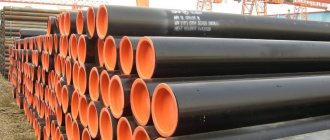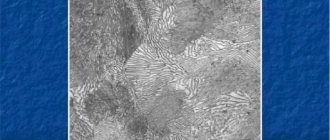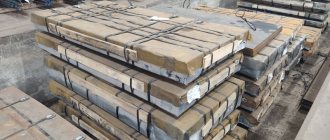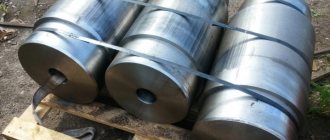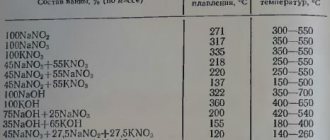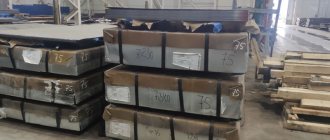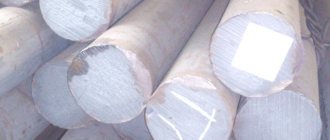The alloy, which is characterized by ease of use, ease of processing, good strength and hardness, as well as low cost, can confidently be called universal, applicable in any conditions. Steel 20 is not a specialized steel; on the contrary, its application possibilities are so wide that it has found a place in almost every industrial sector.
Detailed information on the supply of sheet steel and a price calculator can be found on our website.
Total information
Steel 20 is a structural carbon quality steel widely used in industry. Its popularity is not inferior to 09G2S steel, although in terms of technical and operational characteristics there is a noticeable difference between these grades. Steel 20 is used mainly for the production of parts, welded structures, in construction, and mechanical engineering, but a complete list of industries for its use would take several pages of text. The practicality of steel of this grade allows it to occupy one of the leading positions on the market among ferrous rolled metals.
Application area
- Mechanical engineering. For the production of gears, couplings, components of worm pairs. In addition, they produce first-class fastening devices and connecting elements.
- Pipeline industry for the production of fittings.
- Construction. Due to its most valuable characteristics, ST20 is used for the production of metal structures.
Excellent fastening characteristics during soldering, affordable price, and good strength allow the elements to be used in load-bearing structures.
Characteristics
The metal is characterized by excellent weldability; there are no special requirements for welding, except in cases where the parts have previously been subjected to chemical or heat treatment. Steel 20 is not prone to temper brittleness and is insensitive to flakes and flake sensitivity. The alloy is resistant to pressure treatment, can be cut well by any means, does not crack, and is amenable to surface machining.
Steel 20 is less resistant to chemical attack; contact with alkalis and acids is not recommended. There is no protection against corrosion; products made from steel 20 are not recommended for use in conditions of high humidity, in contact with water without additional protective coatings (zinc, chrome or paint).
Application of steel 20
Steel 20 is used for the manufacture of:
- pipes and pipe fittings, hooks and other parts operated under conditions of high pressure and temperatures from -40°C to 450°C;
- thin spare parts used in conditions of increased abrasion;
- stops, gears, fingers and other parts that are used under low load;
- welded profiles;
- (after chemical-thermal treatment) parts that require enhanced surface strength, but not the core (gears, worms, etc.).
Advantages and disadvantages of steel 20
Steel 20 is distinguished by its quality and relatively low production cost. It is an upgradeable alloy, making it adaptable to a wide range of conditions and, as a result, widespread.
Steel 20 is corrosion-resistant and susceptible to chemical influences - this is its main drawback. The advantages include:
- good weldability without special requirements for the procedure;
- disinclination to temper fragility;
- insensitivity to flakes;
- price-quality ratio;
- material density;
- moderate strength.
Steel 20 is a ferrous metal with a simple composition without expensive alloying additives. The alloy has been produced for a long time, the production process is well studied, optimized, and worked out; There are no special conditions or requirements, so the metal is not very expensive.
Explanation of markings
The marking of steel 20 indicates the chemical composition of the alloy, in particular; on the proportion of carbon in the composition. Since 20 steel is considered high quality, higher demands are placed on the accuracy of its chemical composition.
Chemical composition
The chemical composition of steel 20 includes the following elements and their designations:
- Carbon. The first digit 20 indicates the carbon content in hundredths, i.e. 0.2%. The advantage of steel with a high carbon content is higher strength, but this same indicator leads to a decrease in ductility.
- Silicon. The proportion of silicon in the alloy ranges from 0.17 to 0.35%. Due to the presence of silicon in the metal composition, porosity and the number of gas pockets, which negatively affect the strength of the alloy, are reduced. Pores and cavities are formed due to oxygen, nitrogen and hydrogen gases, the particles of which are removed by silicon.
- Manganese. The proportion of manganese ranges from 0.35 to 0.6%. Manganese, like silicon, prevents oxidation and also removes sulfur from the composition. Thanks to manganese, heat treatment under pressure occurs with a low probability of crack formation, the effectiveness of forging and welding works improves, and the surface of products becomes of higher quality.
- Chrome, copper, nickel. The proportion of nickel and copper usually does not exceed 0.3%, the proportion of chromium; 0.2%. These are alloying additives that have a positive effect on the properties of steel, but in this case their content is insignificant, so they do not have a noticeable effect on the characteristics of the alloy.
- Phosphorus, sulfur. Phosphorus content is permissible up to 0.035%, sulfur; up to 0.04%. These are impurities that have a harmful effect on steel. They increase brittleness and negatively affect toughness, as a result of which the steel loses its resistance to dynamic loads.
- Iron. The rest of the alloy is iron.
Chemical composition in % of material 20
| C | Si | Mn | Ni | S | P | Cr | Cu | As |
| 0.17 — 0.24 | 0.17 — 0.37 | 0.35 — 0.65 | up to 0.3 | up to 0.04 | up to 0.035 | up to 0.25 | up to 0.3 | up to 0.08 |
GOST 1050-88
Characteristics of steel 20
High-quality steel 20 must meet standards, have certain parameters and scope of use. Let's consider due to what characteristics the alloy remains in demand and popular.
Since steel grade 20 is a high-quality material, strict requirements are imposed on its chemical composition. Smelting is carried out according to the rules prescribed in GOST steel 20. The composition includes the following components:
- Iron (Fe) – approximately 98%.
- Carbon (C) – 0.2%. The number 20 in the name indicates the content of this element. Carbon is responsible for strength. The more it is, the harder and more durable the alloy becomes.
- Silicon (Si) – 0.17-0.35%. Needed to remove hydrogen, oxygen, nitrogen from the composition. They increase porosity and the number of gas pockets, which significantly reduce the strength of the metal.
- Manganese (Mn) – 0.35-0.65%. Also a serious deoxidizer, it also promotes the removal of sulfur. Improves surface quality, reduces the risk of cracks during hot working. Thanks to it, welding and forging proceed better.
- Nickel (Ni) – up to 0.3%, chromium (Cr) – up to 0.2%, copper (Cu) – up to 0.3%. The elements lead to improved mechanical and corrosion-resistant properties. However, since their number is small, they do not have a serious effect on the steel.
- Phosphorus (P) – up to 0.035%, sulfur (S) – up to 0.04. Harmful impurities. If their content is too high, the steel becomes too brittle. In addition, the viscosity index drops.
Deoxidation level
- Calm steel 20. Due to the introduction of silicon and manganese, oxygen is completely absent. Iron oxides are also in very small quantities. This ensures “quiet” solidification of the metal in the ladle. The homogeneity and density of ST20 at the outlet are excellent, only a gas shell is formed on top.
- Boiling steel. It is formed by the deoxidation of manganese, which leads to an increase in the content of ferrous oxide. The compound forms carbon dioxide. As a result, gas bubbles form, looking like a boiling mass. Such a metal is very porous, chemical elements are distributed unevenly, which causes deterioration in mechanical characteristics, increases the risk of cracks, and impairs weldability. But there are also advantages - low price, absence of unsafe waste.
- Semi-quiet ST20. Something in between the previous varieties of the alloy.
Types of processing
- forged,
- calibrated,
- hot rolled,
- silver (it has a round base and is coated with a special composition).
The density of steel is 20 - 7850 kilograms per cubic meter. The melting point is 1500 degrees Celsius. The mixture becomes completely liquid at a temperature of 1600 °C. The alloy gives off heat easily, but also accumulates it well. Thermal conductivity coefficient is 48 W/(m deg), specific heat capacity is 490 J/(kg °C). Steel conducts current very well.
The material has low chemical resistance to most acidic compounds. If moisture gets on the surface, rust will remain on it. Because of it, the appearance and strength are greatly deteriorated.
To protect the material from corrosion, galvanic coatings (chrome, zinc, and other similar compounds) should be applied.
The steel is highly plastic, the strength is average, and the hardness is good. The elastic modulus is 200 MPa. The rupture occurs when the greatest elongation is reached at 23-26%, the relative narrowing is even greater - 55%.
Strength indicators are increased by peening, possibly rolling with rollers. Normalization or hardening annealing is performed. In this case we mean the thermal method of exposure.
It is characterized by increased viscosity; accordingly, the alloy is able to withstand impacts. Impact strength – 780 kJ/m².
It lends itself perfectly to pressure treatment and withstands any type of cutting. Stamping is mainly carried out hot. Does not crack during steam treatment and under high pressure. Weldability group 1.
- ST20 is included in the subgroup of cemented alloys. The hardness of the cemented layer is up to 62 HRC, while the core remains “soft”, in the range of 20-35 HRC.
- Chemical exposure and heat treatment (hardening) strengthen the metal and increase its service life.
- Weldability without restrictions, is not characterized by flake sensitivity, and is not prone to temper brittleness.
Types of rental
There are two main technologies for producing rolled profiles from steel 20:
- Hot deformation - used for rolling workpieces more than 4 mm thick. Hot deformation leads to the formation of scale, which is the main disadvantage of this technology.
- Cold deformation; used for rolling thin workpieces (up to 4 mm). As a result of cold deformation, the strength of the alloy increases due to cold hardening.
Types of steel products 20
- profile of all varieties: channel, sheet, I-beam, angle, rod, wire;
- seamless, high-strength pipes obtained by drawing (cold or hot);
- all-welded cold-rolled pipes, welded from a single sheet of steel 20 along the length of the pipe.
Production Standards
- long products, including shaped steel - GOST 1050-88, GOST 2590-2006, GOST 2591-2006, GOST 2879-2006, GOST 8509-93, GOST 8510-86, GOST 8240-97, GOST 8239-89;
- calibrated rod - GOST 7417-75, GOST 8559-75, GOST 8560-78, GOST 10702-78;
- polished rod and silver - GOST 14955-77;
- thick sheet - GOST 1577-93, GOST 19903-74;
- thin sheet - GOST 16523-97;
- tape - GOST 6009-74, GOST 10234-77, GOST 103-2006, GOST 82-70;
- wire - GOST 5663-79, GOST 17305-91;
- forgings and forged blanks - GOST 8479-70;
- pipes - GOST 10704-91, GOST 10705-80, GOST 8731-74, GOST 8732-78, GOST 8733-74, GOST 5654-76, GOST 550-75.
Purpose and application
Steel 20 is one of the most common steel grades in the domestic industry; its versatility allows the production of almost all types of metal products. The main areas of application of steel 20:
- Mechanical engineering. Steel 20 is used to make fastening devices, connecting elements of mechanisms, gears, worms, brackets, bearing shafts, and liners.
- Pipelines. Steel 20 is used to make welded and seamless pipes, shut-off valves and adapters; crosspieces, union nuts, nipples, fittings, hexagons, couplings, taps, manifolds, superheaters, parts of boilers operating under high pressure.
- Construction. Fasteners, hooks, load-bearing trusses, beams and much more. In construction, steel 20 is popular due to its good weldability, satisfactory strength and availability.
Structural quality carbon steel 20
Structural high-quality carbon steel is used for the production of hot-rolled sheets, circles, strips, seamless pipes, electric-welded pipes, hexagons, manifolds, pipelines, superheaters, other parts of high-pressure boilers, sheets for stamping, cemented products with a long service life at temperatures up to +3500C.
Steel 20 is one of the most practical steel grades, widely used for the production of steel pipes and hot-rolled sheets.
Metal grade Substitute
| 20 | 15 |
| 25 |
Three types of steel 20 according to deoxidation level
Deoxidation is the removal of oxygen from the composition of steel 20 in order to reduce the brittleness during hot working. The degree or level of deoxidation can also be called the degree of gas evolution during steel solidification. The intensity of gas evolution or boiling greatly affects the structure of the frozen metal; accordingly, the higher the level of deoxidation, the more solid and durable the structure will be.
Quiet and semi-quiet steel
Steel, which is deoxidized by silicon and manganese, can be maximally purified of oxygen content. Such steel is characterized by a complete structure without bubbles and pores, because the alloy solidifies in a calm state, without active release of gases. The formation of a shrinkage cavity occurs in the upper part; it is removed mechanically.
Quiet steel is more expensive than boiling and semi-quiet steel, because more difficult to produce. It is used in the manufacture of products with high strength requirements, for example, for load-bearing structures, railway tracks, etc.
Semi-quiet steel; an average state between calm and boiling steel, characterized by medium porosity. It comes in different qualities and is used for the manufacture of welded structures, blanks for rolled pipes, and fasteners.
Calm steel has the highest levels of strength and reliability, but its use may not be economically viable in industries where high demands are not placed on steel products.
Boiling steel
Steel 20, the deoxidation process of which is carried out thanks to manganese, contains the largest amount of dissolved gases and iron oxides. When boiling steel hardens, nitrogen and carbon dioxide are actively released, and multiple bubbles and pores are formed. Such steel is inferior to calm and semi-quiet steel in terms of strength, but has a number of positive characteristics. It is perfectly stamped, the process of its production is simpler and cheaper, and the production is waste-free.
Boiling steel is suitable for the production of products that are not subject to high loads during operation. This can be various types of fencing, sheet cladding, and other metal structures.
Mechanical properties
Steel 20 is characterized by high mechanical properties, such as ductility, hardness and strength. The high impact strength allows the steel to adequately withstand increased dynamic loads. Strength is improved by thermal or mechanical treatments - peening, roller rolling, annealing, normalization.
The specific gravity of steel is 7.85 g/cm3. Maximum linear expansion coefficient st 20 = 14.8·10-6 deg-1 at temperatures 27-700°C. Indicators for calibrated hot-rolled steel of the 2nd category: temporary tensile strength 410 MPa, relative elongation after fracture 25%, relative contraction 55%, Brinell hardness 4.8.
Mechanical properties at T=20oC of the material 20.
| Assortment | Size | Eg. | s in | s T | d5 | y | KCU | Thermal change |
| — | mm | — | MPa | MPa | % | % | kJ/m2 | — |
| Heat treated sheet, GOST 4041-71 | 4 — 14 | 340-490 | 28 | |||||
| Hot-deformed pipes, GOST 550-75 | 431 | 255 | 22 | 50 | 780 | |||
| Pipes, GOST 8731-87 | 412 | 245 | 21 | |||||
| Pipes, GOST 10705-80 | 372 | 225 | 22 | |||||
| Rolled products, GOST 1050-88 | up to 80 | 410 | 245 | 25 | 55 | Normalization | ||
| Rolled products cold-hardened, GOST 1050-88 | 490 | 7 | 40 | |||||
| Rolled products annealed, GOST 1050-88 | 390 | 21 | 50 | |||||
| Annealed tape, GOST 2284-79 | 310-540 | 18 | ||||||
| Cold-worked tape, GOST 2284-79 | 490-830 |
Mechanical properties of steel 20 at elevated temperatures 0С
| Temperature tests, °C | σ 0.2, MPa | σ V, MPa | δ5, % | ψ, % | KCU, J/cm2 |
| 20 | 280 | 430 | 34 | 67 | 218 |
| 200 | 230 | 405 | 28 | 67 | 186 |
| 300 | 170 | 415 | 29 | 64 | 188 |
| 400 | 150 | 340 | 39 | 81 | 100 |
| 500 | 140 | 245 | 40 | 86 | 88 |
| 700 | 130 | 39 | 94 | ||
| 800 | 89 | 51 | 96 | ||
| 900 | 75 | 55 | 100 | ||
| 1000 | 47 | 63 | 100 | ||
| 1100 | 30 | 59 | 100 | ||
| 1200 | 20 | 64 | 100 |
Steel endurance limits 20
| σ -1 , MPa | J -1 , MPa | n | δ5 , MPa | σ 0.2 ,MPa | Heat treatment, steel condition |
| 206 | 1E+7 | 500 | 320 | ||
| 245 | 520 | 310 | |||
| 225 | 490 | 280 | |||
| 205 | 127 | Normalization 910 C, release 620 C. | |||
| 193 | 420 | 280 | |||
| 255 | 451 | Cementation 930 C, hardening 810 C, tempering 190 C. |
Mechanical properties of steel 20 after chemical treatment
| Section, mm | σ 0.2 , MPa | σ V , MPa | δ5, % | y, % | KCU, J/m 2 | HB | H.R.C. |
| Cementation 920-950 °C, air. Quenching 800-820 °C, water. Vacation 180-200 °C, air. | |||||||
| 50 | 290-340 | 490-590 | 18 | 45 | 54 | 156 | 55-63 |
| Temperature of critical points, °C | |||
| Ac1 | Ac3 | Ar1 | Ar3 |
| 735 | 850 | 680 | 835 |
physical characteristics
| Temperature | E, GPa | G, GPa | r, kg/m3 | l, W/(m °С) | R, NOM m | a, 10-6 1/°С | C, J/(kg °C) |
| 100 | 208 | 77 | 7834 | 51 | 219 | 123 | 486 |
| 200 | 203 | 76 | 7803 | 49 | 292 | 131 | 498 |
| 600 | 163 | 59 | 7659 | 36 | 758 | — | 584 |
| 1200 | — | — | — | — | — | — | 695 |
Technological properties
Steel 20 is a high-tech alloy classified as cemented. The cementation process is the saturation of the surface of a product with carbon by heating in a special environment. As a result of this treatment, the top layer of the product acquires a hardness value of up to 62 HRC, which is three times higher than that of the core. The metal lends itself well to forging, cutting and soldering, is not prone to cracking, and retains high density. All popular methods are applicable for welding - ADS, KTS, RDS, submerged arc welding, etc. The type of equipment depends on the selected welding technology.
| Forging | Forging temperature, °C: beginning 1280, end 750. Cooling in air. |
| Weldability | Weldable without restrictions, except for parts after chemical-thermal treatment. Welding methods: manual arc welding, automatic arc welding, resistance welding. |
| Machinability | In the hot-rolled state at HB 126-131 and σв= 450-490 MPa: Kv hard alloy= 1.7 Kv high-speed steel= 1.6 |
| Flokensensibility. | Not sensitive |
| Tendency to temper brittleness | Not inclined |
Impact strength of steel 20 KCU (J/cm3) at low temperatures °C
| Compliance with GOST | Type of delivery | Section, mm | KCU at +20 | KCU at -40 | KCU at -60 |
| 19281-73 | Long and shaped rolled products | from 5 to 10 | 64 | 39 | 34 |
| from 10 to 20 incl. | 59 | 34 | 29 | ||
| from 20 to 100 incl. | 59 | 34 | — |
Steel yield strength 20
| Test temperature, °C/s0,2 | |||||||
| 150 | 200 | 250 | 300 | 320 | 350 | 400 | 450 |
| ≥215 | ≥210 | ≥196 | ≥180 | ≥160 | ≥137 | ≥127 | |
Hardness
| Hardness 20 after annealing, GOST 1050-88 | HB 10-1= 163 MPa |
| Hardness 20 calibrated cold-worked, GOST 1050-88 | HB 10-1= 207 MPa |
| Hardness 20, Heat treated sheet. GOST 4041-71 | HB 10-1= 127 MPa |
| Hardness 20, Hot deformed pipes. GOST 550-75 | HB 10-1= 156 MPa |
| Hardness 20, Pipes GOST 8731-87 | HB 10-1= 156 MPa |
| Hardness 20, Thick sheet annealed. GOST 1577-93 | HB 10-1= 156 MPa |
Chemical composition
| Standard | C | S | P | Mn | Cr | Si | Ni | Fe | Cu |
| GOST 21729-76 | 0.17-0.24 | ≤0.035 | ≤0.035 | 0.35-0.65 | ≤0.25 | 0.17-0.37 | ≤0.25 | Remainder | ≤0.2 |
Fe is the basis. According to TU 14-1-1672-76, the chemical composition is given for steel grade 20A. The residual copper content is allowed no more than 0.25% when steel is smelted using the scrap process. Deviations from the norms of chemical composition are allowed in accordance with GOST 1050. Upon request, steel can be supplied with narrowed carbon content limits - “select”: 0.19-0.25%; 0.19-0.23%; 0.22-0.25%; 0.21-0.24%. According to GOST 1050-88, the nitrogen content is indicated for steel using the oxygen-converter smelting method. For all other types of steelmaking, the nitrogen content is N≤0.008%. According to TU 14-1-5185-93, TU 14-1-5058-91, the chemical composition is given for steel grade 20pv. According to TU 08.002.0501.5348-92, the chemical composition is given for steel grade 20-Sh. According to TU 14-1-3987-85, the chemical composition is given for steel grade 20. According to TU 14-1-1529-2003, TU 14-3-460-2003 and TU 14-3-341-75 for steel made from scrap process or from cuprous ores, the mass fraction of residual copper and nickel is allowed up to 0.30% each. The technological addition of rare earth elements is allowed to improve the quality of the metal. According to TU 14-3R-55-2001, the chemical composition is given for steel 20; for steel 20-PV, the mass fraction of carbon is 0.18-0.24%, chromium, nickel, copper, sulfur and phosphorus ≤ 0.15% each, the mass fraction of other elements is identical to steel grade 20. In steel 20, nickel and chromium no more than 0.40% each. The presence of rare earth elements introduced as technological additives is allowed. According to GOST 19277-73, GOST 21729-76, the chemical composition is given for steel 20A. When smelting steel using the scap process, the mass fraction of copper should be ≤ 0.25%. Maximum deviations for the chemical composition are in accordance with GOST 1050. According to TU 1317-006.1-593377520-2003, the chemical composition is given for steel grade 20A. The mass fraction of hydrogen in steel in the pipe metal should not exceed 1.0 ppm (2.0 ppm in the ladle sample. It is allowed to introduce niobium and titanium to obtain a mass fraction of up to 0.030% and 0.010%, respectively. In deoxidized steel for globularization of sulfide inclusions calcium (silicocalcium) or cerium is introduced to obtain a mass fraction of 0.050%. According to TU 14-162-14-96, the chemical composition is given for steel grade 20A. Deviations in the content of carbon (-0.020%), aluminum (±0.010%) are allowed in steel ), manganese (+0.15%), sulfur (+0.005%), phosphorus (+0.005%). In order to increase strength properties, it is allowed to introduce vanadium into steel in an amount of up to 0.050%. According to TU 14-3-1971-97 The chemical composition is given for steel grade 20B with increased corrosion resistance and operational reliability. To ensure a fine-grained structure, vanadium is introduced up to 0.06%. The carbon equivalent SEq should not exceed 0.40%. According to TU 1301-039-00212179-2010, the chemical composition is given for steel grade 20-Sh. The content of each impurity element not regulated by the table is allowed up to 0.050%. According to TU 108.1273-84, deviations for nickel are +0.20%, for copper +0.20%. According to TU 14-158-113-99, the chemical composition is given for steel grade 20 with increased corrosion resistance and cold resistance. In the finished metal, deviations in chemical composition are allowed in accordance with GOST 1050, in addition - for aluminum + 0.0050%. When the mass fraction of nitrogen is more than 0.0080%, microalloying with vanadium of at least 0.030% is mandatory. According to TU 14-161-149-94, the chemical composition is given for steel grade 20 for hydrogen sulfide- and cold-resistant casing pipes and couplings.
Physical properties
The melting point of steel 20 is 1500C, steel becomes liquid at 1600C. Steel 20 has good thermal conductivity and heat capacity. The modulus of elasticity, coefficient of thermal expansion, thermal conductivity, density, specific heat capacity and electrical resistivity for various temperatures are shown in the table below.
Physical properties of the material 20 .
| T | E 10- 5 | a106 | l | r | C | R 109 |
| hail | MPa | 1/Grad | W/(m deg) | kg/m3 | J/(kg deg) | Ohm m |
| 20 | 2.13 | 52 | 7859 | |||
| 100 | 2.03 | 11.6 | 50.6 | 7834 | 486 | 219 |
| 200 | 1.99 | 12.6 | 48.6 | 7803 | 498 | 292 |
| 300 | 1.9 | 13.1 | 46.2 | 7770 | 514 | 381 |
| 400 | 1.82 | 13.6 | 42.8 | 7736 | 533 | 487 |
| 500 | 1.72 | 14.1 | 39.1 | 7699 | 555 | 601 |
| 600 | 1.6 | 14.6 | 35.8 | 7659 | 584 | 758 |
| 700 | 14.8 | 32 | 7617 | 636 | 925 | |
| 800 | 12.9 | 7624 | 703 | 1094 | ||
| 900 | 7600 | 703 | 1135 | |||
| 1000 | 695 | |||||
| T | E 10- 5 | a106 | l | r | C | R 109 |
Composition of steel grade 20
The chemical composition of steel 20 is regulated by GOST 1050-58. According to his requirements, the mass fraction of carbon in the ladle sample of the alloy should be from 0.17% to 0.24%. Therefore, steel 20 is classified as low-carbon.
Standards for the content of other chemical elements in it according to GOST:
- nickel and copper - no more than 0.3%
- arsenic - not higher than 0.08%;
- manganese – 0.35% – 0.65%;
- chromium – not higher than 0.25%;
- silicon – 0.17% – 0.37%;
- sulfur and phosphorus - respectively, no more than 0.040% and 0.035%.
Characteristics of material 20L
Brand: 20L Substitute: 25L, 30L
Classification: Casting steel, unalloyed
Application: chabots, fittings, shaped castings of general mechanical engineering parts produced by the lost wax method, parts of welded cast structures and other parts operating at temperatures from -40 to 450 °C.
Types of supply of material 20L
| B42 - Rails. Overlays. Linings. Crutches | GOST 7370-98 Railway crosspieces of types P75, P65 and P50. Specifications |
| B82 – Steel castings | GOST 977-88 Steel castings |
Chemical composition in % of material 20L GOST 977 - 88
C Si Mn S P0.17 — 0.250.2 — 0.520.45 — 0.9 to 0.06 to 0.06
| Note: The proportion of phosphorus and sulfur impurities depends on the group of castings and the type of steel smelting |
The temperature of the critical points of the material is 20L.
Ac1 = 735, Ac3(Acm) = 854, Ar3(Arcm) = 835, Ar1 = 680 Technological properties of material 20L.
| Weldability: | no limits. |
| Flock Sensitivity: | not sensitive. |
| Tendency to temper brittleness: | not inclined. |
Foundry and technological properties of material 20L.
| Linear shrinkage: | 2.2 — 2.3 % |
Heat treatment modes for 20L material
| Normalization 880 - 900 ° C or Normalization 880 - 900 ° C, Vacation 630 - 650 ° C |
Mechanical properties at T=20oC of material 20L.
| Assortment | Size | Eg. | sв | sT | d5 | y | KCU | Thermal change |
| — | mm | — | MPa | MPa | % | % | kJ/m2 | — |
| Castings, K20, GOST 977-88 | up to 100 | 412 | 216 | 22 | 35 | 491 | Normalization 880 - 900oC, Vacation 630 - 650oC, |
Physical properties of material 20L.
| T | E 10- 5 | a 10 6 | l | r | C | R 10 9 |
| hail | MPa | 1/Grad | W/(m deg) | kg/m3 | J/(kg deg) | Ohm m |
| 20 | 2.01 | 54 | 7850 | 170 | ||
| 100 | 1.96 | 12.2 | 53 | 487 | 220 | |
| 200 | 1.88 | 12.7 | 51 | 500 | 294 | |
| 300 | 1.83 | 13.1 | 48 | 517 | 385 | |
| 400 | 1.73 | 13.5 | 43 | 533 | 490 | |
| 500 | 1.65 | 13.9 | 39 | 559 | 604 | |
| 600 | 1.52 | 14.4 | 35 | 588 | 761 | |
| 700 | 1.32 | 14.9 | 32 | 638 | 932 | |
| 800 | 1.2 | 12.6 | 27 | 706 | 1101 | |
| 900 | 12.4 | 27 | 706 | 1139 | ||
| T | E 10- 5 | a 10 6 | l | r | C | R 10 9 |
Foreign analogues of material 20L
Attention! Both exact and closest analogues are indicated.
1.0443
| USA | Germany | Japan | France | England | Italy | Poland | Czech | Austria |
| — | DIN,WNr | JIS | AFNOR | B.S. | UNI | PN | CSN | ONORM |
1A
| ||||||||
| 1.0619 | ||||||||
| GP240GH | ||||||||
| GS45 |
| SCPH1 |
Designations:
| Mechanical properties : | |
| sв | — Short-term strength limit, [MPa] |
| sT | — Proportional limit (yield strength for permanent deformation), [MPa] |
| d5 | — Elongation at break, [%] |
| y | — Relative narrowing, [%] |
| KCU | — Impact strength, [kJ/m2] |
| HB | — Brinell hardness, [MPa] |
| Physical properties: | |
| T | — Temperature at which these properties were obtained, [Deg] |
| E | — Modulus of elasticity of the first kind, [MPa] |
| a | — Coefficient of thermal (linear) expansion (range 20o - T), [1/degree] |
| l | — Thermal conductivity coefficient (heat capacity of the material), [W/(m deg)] |
| r | — Material density, [kg/m3] |
| C | — Specific heat capacity of the material (range 20o — T), [J/(kg deg)] |
| R | — Electrical resistivity, [Ohm m] |
| Weldability: | |
| no limits | — welding is performed without heating and without subsequent heat treatment |
| limited weldability | — welding is possible when heated to 100-120 degrees. and subsequent heat treatment |
| difficult to weld | — to obtain high-quality welded joints, additional operations are required: heating to 200-300 degrees. during welding, heat treatment after welding - annealing |
